![[later] I don't get why our pizza slices have such terrible reviews; the geotextile-infused sauce gives the toppings incredible slope stability! [later] I don't get why our pizza slices have such terrible reviews; the geotextile-infused sauce gives the toppings incredible slope stability!](https://imgs.xkcd.com/comics/tariffs.png)

1) You want a pizza made from another region.
2) However, you must sell them some your ingredients before it can be made.
3) They charge a “tariff” to protect the income of their local farmer’s for other ingredients. You’re willing to pay the “tariff” because you like your ingredients better.
4) The pizza maker sells you the final pizza with a standard sales tax but no tariff
5) You paid the higher price and they made money from the tariff.
Trump is charging tariffs to increase the costs from other regions for several reasons. A) To negotiate down tariffs from other regions. B) Lower tariffs mean you pay a lower cost for your special pizza. C) To whittle down our regions deficit. D) and/or To increase local “ingredients” growth at lower cost for you.

One thing about King Trump and President Musk and Senior Advisor Big Balls destroying government capability is that it destroys all the little things that the U.S. government could do to make things just a little better. There are so many examples. Here’s one, on USAID and global cultural heritage.
Development agencies such as USAID have become increasingly entangled with heritage – an entanglement that has come in for criticism. Conflict in the Middle East – and the US ‘war on terror’ – has been one recent driver of such work, which has often been tied to community- and peace-building, and reconstruction initiatives (successfully or otherwise). Earlier drivers included disaster (heritage recovery efforts after the Venice and Florence floods of 1966, for example) and infrastructural projects with a modernising purpose: UNESCO’s International Campaign to Save the Monuments of Nubia, which drew a variety of international donors including the United States, took place due to Egypt’s construction of the Aswan High Dam during the 1960s.
In recent decades, a veritable ‘heritage-industrial complex’ has therefore come to exist globally, with money provided by a variety of organisations. Those organisations are state-level ones such as USAID, non-state institutions such as the Aga Khan Trust, and also ones channelling donations from a number of member-states: ALIPH (the International Alliance for the Protection of Heritage) was initially funded by France and the United Arab Emirates, but now has numerous state-level donors.
As US policy changes, however, and as European and other government spending is redirected towards defence against Russia, the likelihood of sustained levels of development funding for heritage projects is low, unless those projects can be attached to infrastructure work for the global defence industry (an unlikely proposition). Giving development money to heritage projects has never been straightforward. But it is because it has never been straightforward that the loss will be more keenly felt.
USAID’s funding of heritage work demonstrates why ‘heritage’ has never been the only objective of spending that money. Take the American Research Center in Egypt (ARCE), which was founded in 1948. ARCE administers an ‘Antiquities Endowment Fund’ (partially endowed by USAID) that ‘sustains an ongoing grants program to support the conservation, preservation and documentation of Egypt’s cultural heritage and the dissemination of knowledge about that heritage’. Many of the fund’s grants go to an international cadre of Egyptologists, who in this case have become ‘heritage professionals’ akin to the legion of outside experts so familiar from other kinds of development work around the world.
Such projects, though, also employ people locally. In 2023, USAID granted ARCE money for what was called its ‘Cultural Heritage Tourism II’ project. That project involved building a new storage magazine at Karnak Temple in Luxor and the ‘development of visitor infrastructure’ at the archaeological site of Abydos in Upper Egypt (the project ended in September 2024). Projects like these employ numerous people from such places: in tourism, building, conservation work and other fields. For better or for worse (there are arguments on both sides), these projects are a part of local economies. Removing that money suddenly is potentially disastrous, particularly as new projects along these lines are being launched all the time: in late 2024, the State Department partnered with ARCE to launch a central cataloguing system for Egypt’s museums.
The problem of course is that none of this has a political constituency, so it’s always vulnerable. Me, I’d say that cataloguing Egyptian museums is a really good thing to do. But really, hardly anyone cares. So here we are.
The post The Little Things appeared first on Lawyers, Guns & Money.
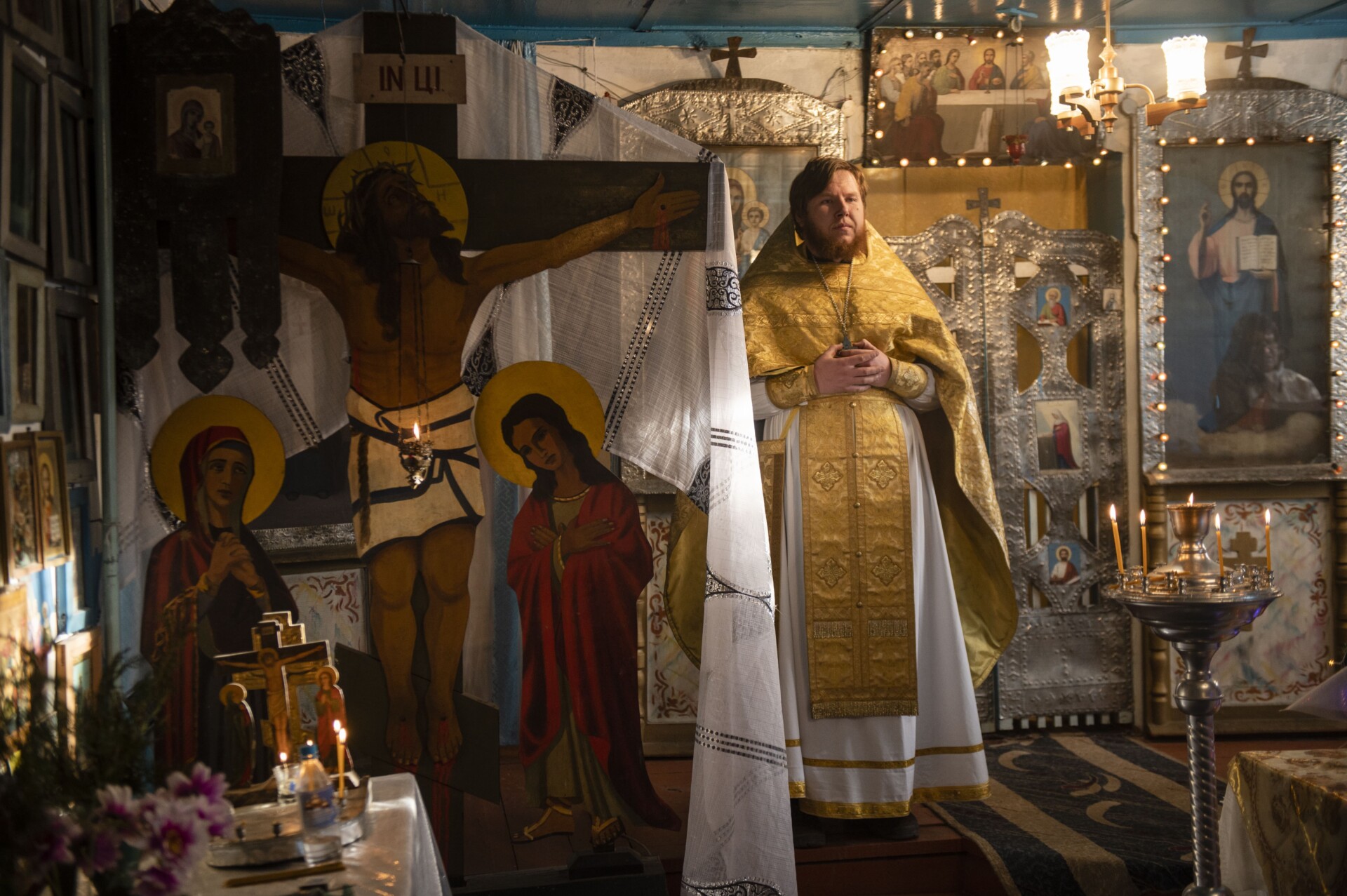
It takes three hours to heat the church. The walls are cracked, and the window panes freeze in winter. The Rev. Dionisy Zorin starts up the coal stove at 5 in the morning. By 8 a.m., the temperature is just about bearable.
Twenty-seven-year-old Zorin came to Suluktu in October 2023.
He didn’t want to be assigned to this small town at the southwestern tip of Kyrgyzstan on the Tajik border. But as a young priest, he was eager to make his mark, even if that meant moving to a town of 24,000 people that is fighting unemployment and pollution from coal mining.
“Suluktu is a symbol of exile, a threat used against insubordinate priests,” Zorin says. But Kyrgyzstan's eparch, a position in the Orthodox Church similar to a bishop, begged him, “Take a look at least.” So he did.
“I slept in the church and next morning decided I wanted to try. I saw a spiritual emptiness in the eyes of the people,” Zorin tells me in front of the church as we sit on a bench. If not for the cross, one could be forgiven for not knowing this small building, with its crooked porch and corrugated metal roof, is a church. The area is overgrown with bushes.
Suluktu is Zorin’s first parish, and it is far from easy. He is the first priest to be assigned to this remote town in 35 years. Twenty-seven locals petitioned the church authorities in Bishkek, the capital of Kyrgyzstan, writing a letter to request a priest after decades of waiting. They also wrote to the patriarchate in Moscow, where the Russian Orthodox Church is headquartered.
But when the young priest arrived, the petitioners were uninterested, even bordering on hostile. For all their pleas and hankering for spiritual nourishment, almost no one comes to his church services. Though he is ethnically Slav like many of the parishioners, they mostly see Zorin as a stranger. Born after the collapse of the Soviet Union in the early 1990s, he is well integrated into Kyrgyz society. Russia is his spiritual homeland, but he likes and feels patriotic toward Kyrgyzstan.
In this parish, in a desolate, far-flung spot of the former Soviet empire — closer to China than to Moscow — residents are faithful to Russia, or at least their idea of it. Though they have Kyrgyz citizenship, in their minds they remain loyal to the country that is long gone, the Soviet Union, whose mythology and past greatness still loom large for them.
This tiny Russian-speaking minority is now engulfed in a battle over who has the right to decide their heritage and their future. They nurture a private conviction of cultural superiority over their ethnically Kyrgyz neighbors — a phenomenon that plays out across the ex-Soviet countries of Central Asia and the Caucasus, wherever there are pockets of Slavic populations. They quarrel about who is the most “European” — essentially meaning Slav — among them, emphasizing their devotion to the Orthodox Church. The arrival of Zorin, an ethnic Russian with a Kyrgyz identity, has intensified their existential confrontation: Should he get to decide what to do with their church or should they? And if it is the parishioners, why can they not reach a compromise?
Zorin was born in the area of Issyk-Kul, a picturesque lake with azure waters that makes it one of Kyrgyzstan’s primary tourist attractions. It lies some 900 miles northeast of Suluktu. Zorin grew up among the Kyrgyz. If not for his Slavic facial features distinguishing him from his Asian compatriots, one would have thought Kyrgyz was his mother tongue.
He developed a fascination with the Orthodox Church after a Russian classmate took him there. The spectacle — “the clothes, smells, the show” — enveloped him, and he was entranced. It was then, at 14 years old, that he decided he wanted to become a priest.
His parents, both atheists, were not enthusiastic. But Zorin was determined. He graduated from the seminary of the Russian Orthodox Church in Tashkent, Uzbekistan, the top place to study in Central Asia for those wishing to enter the church. To be on the safe side, he also earned a degree in Kyrgyz literature. He even married. But this, he admits, was “to please my mother.” After a quick divorce, Zorin embraced celibacy.
“As a priest you’re constantly confronted with temptations,” he admits. Luckily, in Suluktu, where there are no places to meet women — no cinema or bookshop, and only a few cheap eateries — such temptations are few.
The young priest survives on a lean budget. The eparchy sends him the equivalent of $225 per month. Most of this is spent on the church. Any other income he earns in Osh, a city about 250 miles to the east of Suluktu. For half the month, Zorin teaches the Kyrgyz language there.
More often than not, he is a priest with few or no parishioners.
“As soon as I leave, people complain that the church is closed. When I’m back, no one visits. It’s schizophrenic,” he laments.
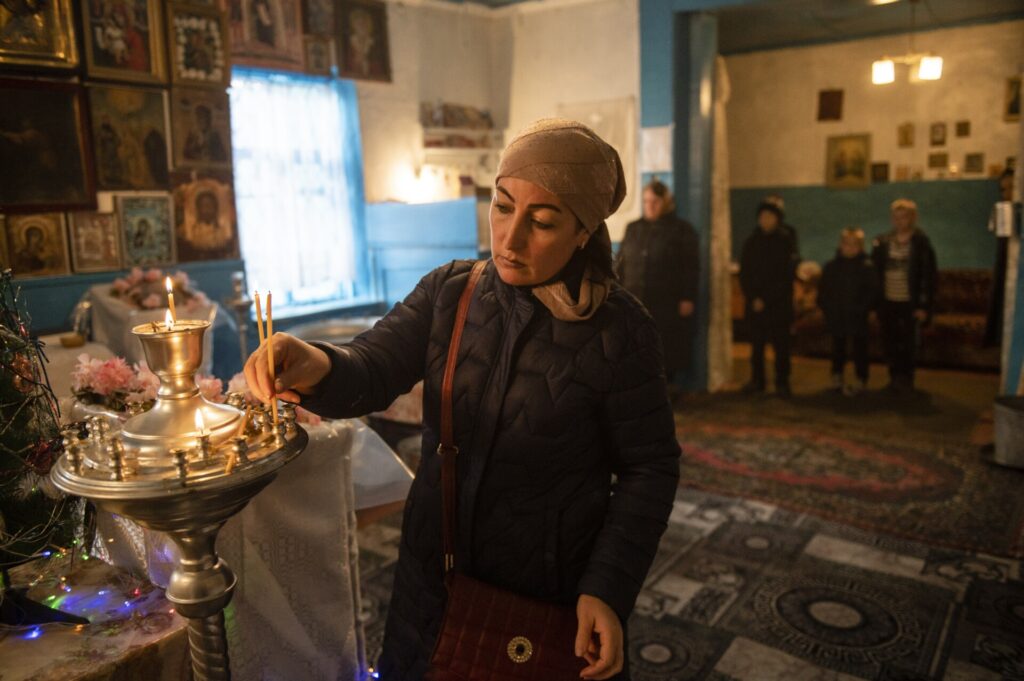
The Russian Orthodox Church was introduced in Kyrgyzstan when mostly Muslim Central Asia was incorporated into the Russian Empire in the second half of the 19th century. By the time of the October Revolution in 1917, when the Bolsheviks were sweeping to power, there were already 30 churches in what is now Kyrgyzstan. Some of them were destroyed during the purges of Josef Stalin, but many reopened during and after World War II.
Zorin’s church, whose full name is the Church of the Intercession of the Virgin Mary in Suluktu, opened in 1934. The clay building used to be the private house of a Tatar family.
“Formally it isn’t actually a church but a house of prayer,” Zorin admits. Normally, a sacred stone and a capsule with relics are placed under a properly founded Orthodox church, he stresses. In Suluktu there is no such stone or capsule. Zorin hopes to embed them when his renovation work begins in earnest.
The Orthodox Church of Kyrgyzstan is under the authority of the Moscow patriarchate. Before 2011, it was part of the eparchy in Tashkent. Later on, the Holy Synod of Russia created a separate Kyrgyz eparchy with its seat in Bishkek. Most believers are first- or second-generation Russians, Ukrainians and Belarussians, or a mixture.
Suluktu is the smallest of Kyrgyzstan’s 46 parishes and therefore not a priority for the church. Its “European” population is estimated to be upward of 740 people, according to the informal body of the Russian diaspora. Their ethnically Kyrgyz neighbors, who form the vast majority of the town, tend to regard them with contempt — at the Russians’ fondness for alcohol and, as they see it, for not taking proper care of their elderly, a taboo in Kyrgyz society. That is if they notice them at all.
“The majority of the Kyrgyz population can’t even tell that there is an Orthodox church in town,” said Suluktu’s mayor, Bolot Abdyjaparov.
No priest wanted to be appointed here. Most didn’t even want to visit. Within the past decade, three priests from other Orthodox parishes have come by. The priest from Kyzyl-Kyya, a town some 125 miles from Suluktu, wanted money thrown his way just to come and take a look. Another priest used to arrive drunk. And the third one was chased away for sexual misconduct, the locals say. After years of being deprived of pastoral care, the Suluktu residents became used to living in a state of spiritual neglect.
Zorin often spends all day waiting out in front of the church, hoping some will come inside to pray or take comfort in the holy surroundings. But out of the 27 people who signed the letter to the eparchy asking for a priest, only two regularly show up for services: a couple, Irina Belova, a devout 64-year-old, and Dmitri Nikitenko, a widower often glued to his smartphone watching weather patterns across the world.
They live together in a clay house built by German prisoners during World War II. Its floor is littered with clothes, and water drips from the drying wet laundry. Their metal beds give the place a sterile, hospital feel.
A Russian TV channel plays news from the front line in Ukraine.
Today, Belova is Zorin’s right-hand woman. She opens and closes the church when he is away. She recites prayers and sings at services. She also cooks for him and does his laundry. Belova says she discovered God when she was in her 30s.
“I felt light as a bird,” she recalls, her eyes glimmering. She had dreamed of becoming a nun, but her late husband was alive, preventing the Orthodox convents in Kyrgyzstan from accepting her.
When heavy rain collapsed one of the church walls in 2001, Belova was the first to collect the icons, some dating to the 16th century, from under the rubble. That night she slept in the church, guarding them from thieves.
The couple met at a construction site almost four decades ago and moved in together recently. “Out of convenience,” says Nikitenko, smiling. “It’s boring to be alone.”
A photograph of his late wife hangs above his bed. The couple’s children from previous marriages are scattered across former Soviet republics, symbolic of the decay and lack of opportunity in a place like Suluktu.
Belova’s oldest son, whom she calls “Father Mikhail,” is a clergyman in St. Petersburg. When he had his religious calling at a young age, the Suluktu residents collected money to send him to the Orthodox seminary in Tashkent, the same one that Zorin attended. After graduating, he was supposed to return and pastor the local church. But he chose Russia instead. In the 1990s, the Kyrgyz government initiated dynamic reforms that were to turn the state-controlled economy into a market economy. This shock therapy bankrupted many key industries. While the rest of Kyrgyzstan gradually recovered, the southern provinces — Batken (where Suluktu is), Osh and Jalal-Abad — had other problems to cope with. In Suluktu, the coal mines that had been established in the mid-19th century closed, plunging the town into unemployment. Many Russian-speaking residents left to look for jobs in Russia.
Belova also tried to leave. She followed her daughter, who found a job in Tolyatti on the Volga River in Russia. But Belova felt trapped in the big city with her daughter at work and her grandchildren away at school. Eventually, she packed her suitcase and returned to Kyrgyzstan. Now she sees her daughter and three sons, all of whom live in Russia, only on WhatsApp video calls.
Nikitenko’s children are split between Belarus and near the Sea of Azov, which sits between Ukraine and Russia. While he has visited both places, neither felt like home, so he also returned to Suluktu.
Other parishioners gossip about Belova and spread malicious rumors about her, including that she buried a newborn baby in her backyard. When asked about it, Belova quickly changes the subject. Belova has little time for slander; she is not well. After being diagnosed with breast cancer, she had a mastectomy, and a roll of toilet paper now sits in her bra. The cancer has now spread to her abdomen, and she is due for another round of surgery soon.
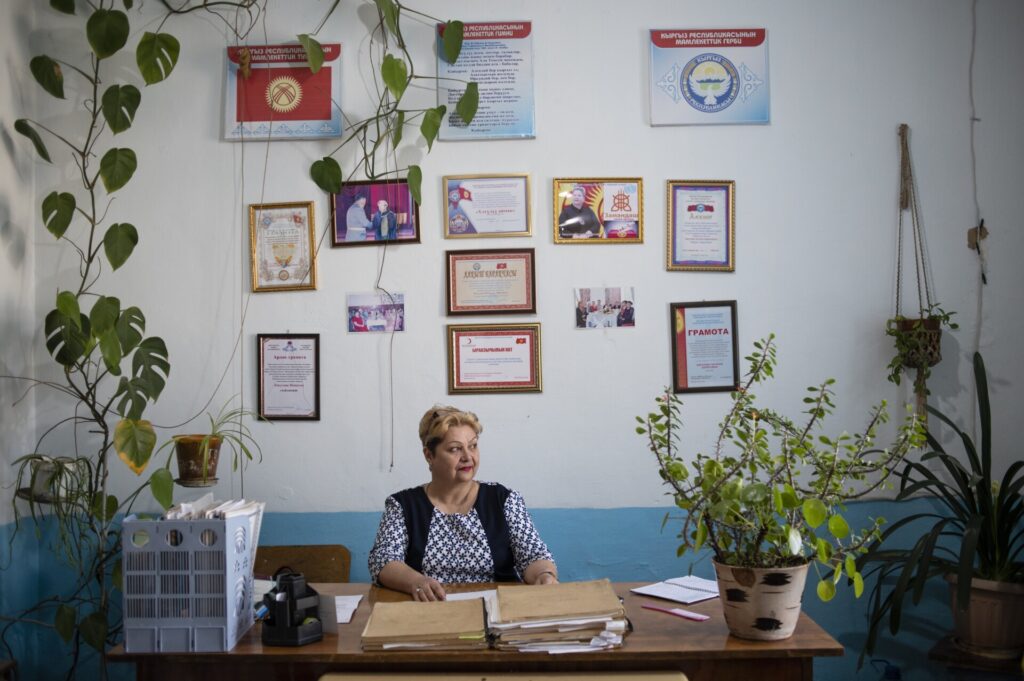
One of Belova’s main adversaries is Natalia Balakina, who co-wrote the letter to the Bishkek eparchy asking for a priest. The Suluktu church is personal for Natalia — her grandfather was an Orthodox priest who was brought from Tashkent in 1961 to oversee it, some eight years after Stalin’s death.
Belonging to the clergy in Soviet days was difficult, but he managed by working as a veterinarian and treating the horses of the Communist Party functionaries, which guaranteed him a secure, and elite, existence.
“There are very few of us Europeans here,” sighs 56-year-old Natalia from the sofa in her Soviet-built apartment on the outskirts of Suluktu.
Behind her are shelves packed with old porcelain and classic works of Russian literature. A giant teddy bear looks down on us — it is a mascot from the 1980 Moscow Olympics, a souvenir from a holiday in Russia long ago. Her younger sister, Aleksandra, has been to Russia three times. They include Ukrainians in the category of “European,” along with Tatars. But they call the rest, and majority, of the population in Kyrgyzstan — the Kyrgyz, Tajiks and Uzbeks — “nationals.” It carries with it a sharp racist undertone.
“Few Kyrgyz lived here before,” Natalia says of Suluktu with a grimace on her face. “It was a European town.” During the heyday of the Soviet Union, the state, in an effort to attract workers, offered high salaries and goods that were comparable to those of the main cities of Russia. Suluktu’s shops even sold the newest fashions from Moscow — a far cry from the town’s current increasing state of decay.
Their father, an engineer, built much of the town’s infrastructure, including the apartment complex where the sisters live. Perhaps that’s why they never left. “Only old and sick people remained, or such who have a particular connection to the town,” Natalia says. The sisters have both; their 82-year-old mother hasn’t left her bed for years because of a broken hip.
During the time of the Soviet Union, borders between the Central Asian republics mattered little. This changed after independence, and the delineation of the borders became a tedious and delicate task.
Large tracts along the nearly 620-mile-long border with Tajikistan still remain contested. Bloody interethnic clashes between the Kyrgyz and Uzbek populations shook the south of the country in 2010, contributing to the general feeling of insecurity and forcing non-Kyrgyz people to move. Tajikistan’s army attacked Kyrgyz territories in 2021 and 2022. Border clashes, which also occurred in the vicinity of Suluktu, claimed more than 200 lives; hundreds were displaced. It also explains why there are few ethnic Russians in the south of Kyrgyzstan compared with the north.
Natalia’s first husband also left for Russia. Her second husband, a miner, has been unemployed for years. The mines in Suluktu are now “in Kyrgyz hands,” she complains, alleging that they don’t want to employ Russians. Her older son hanged himself; the younger has epilepsy.
Aleksandra is not much happier than her sister. For two years she has worn only black, after her husband died of cancer. United in sorrow, the two sisters set themselves the ambitious goal of building a new church. Their public foundation, called “Heritage” (“Nasledie” in Russian), began collecting donations and employed an architect who declared the old church building unsafe. It still bears the marks of a fire caused by a faulty electrical installation. After the wall collapsed, a metal frame was introduced to hold the walls together.
The building is situated on municipal land, and in 2022, the mayor suggested that the parish find a new plot on the outskirts. Zorin is planning a major renovation of the church, but the sisters prefer the land swap. He is suspicious of them — they do not attend his services. To be on the safe side, he has deposited all the church’s documents with a lawyer in Osh. “If something happens, he will know what to do.
“The town may look peaceful, but a war of empires is going on here,” Zorin says. “Protestants get money from South Korea and the United States, and Muslims from the Gulf countries. It’s only us who barely manage to make ends meet.” After the collapse of the Soviet Union in 1991, and after the Central Asian republics gained their independence, a string of countries became the key investors in the construction of mosques in the region, namely Saudi Arabia, Turkey, Qatar and the United Arab Emirates. In the three decades since independence, the mosques in Suluktu grew in number from one to 52 — in all of Kyrgyzstan, from a few dozen to over 2,000.
Islam remains the primary faith in the country, but the state is secular, and the constitution guarantees freedom of religion. Over 3,000 religious organizations are registered with the State Commission for Religious Affairs; nearly 400 of those are Christian. Estimates vary, but Christians are believed to constitute up to 7% of Kyrgyzstan’s religious population. Within that percentage, the majority are Orthodox, followed by Roman Catholics and Protestants. Evangelical churches from North America, South Korea and Europe became especially active throughout the post-Soviet world in the 1990s. The Suluktu residents are convinced that South Koreans sponsored the local Adventists and even call them a “Korean church.” The head of the Adventists in Suluktu confirms that he received his training in South Korea but says that his church subsists on donations from within Kyrgyzstan.
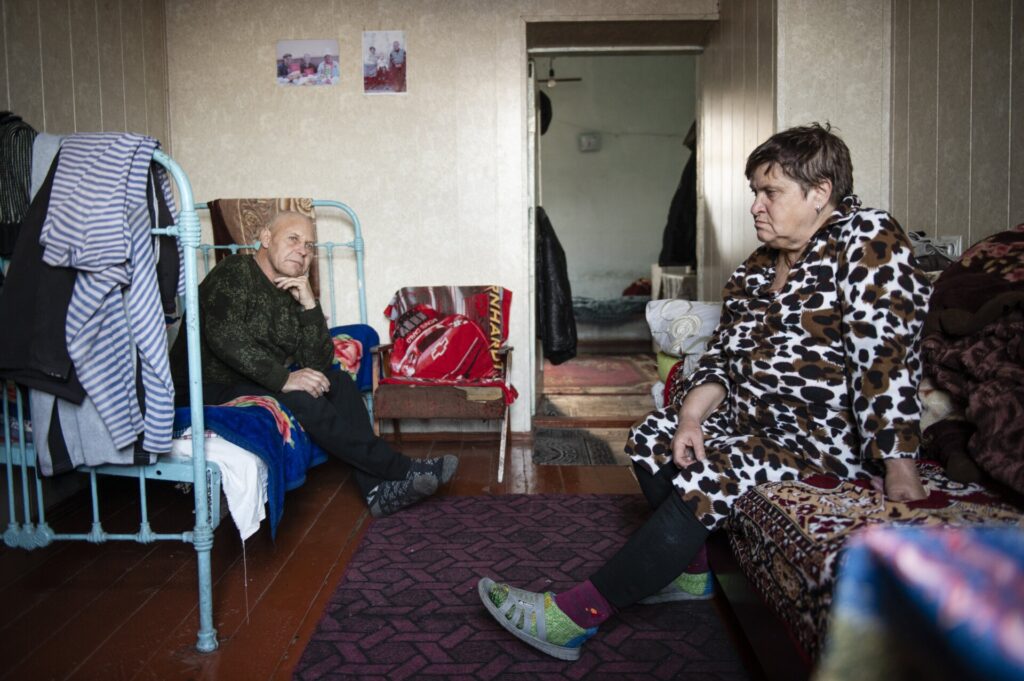
Natalia Bikulova, an energetic 59-year-old, is the town’s informal head of the Russian diaspora. She is a self-described workaholic, toiling away in an office serving the city, coordinating distributions of coal and basic supplies like food. She is the first point of contact when the lights go off or when water stops running from the tap — events that happen regularly in Suluktu.
Like the Balakina sisters, she is also dissatisfied with Zorin’s management of the church. Bikulova is immensely attached to it, having attended since the late 1980s, discovering her Orthodox identity as communism collapsed around her. By 1989, the last priest had already left and old women were taking care of the church. A decade later, Bikulova became a “starosta” — a person responsible for maintaining the parish. She even learned how to conduct funerals; she would call the eparchy in Bishkek to ask which prayers should be read.
“We were left alone and learned to do things on our own,” she says.
She now goes to Zorin’s church services but thinks he has done a terrible job of renovating.
“Father Dionisy has big ambitions but no social skills,” she says. “Have you seen that ugly blue? Our church used to be so beautiful!” she says with disdain, adding that the previous shade of blue was more inviting.
Bikulova was born in the town of Legnica, Poland, which was the location of a forced-labor and POW camp during World War II. Until 1993, Soviet-mandated troops were stationed in Legnica because it was close to the German border. Bikulova learned military drills as she grew up there. Then she went to Tashkent in the then-Soviet Union to study, later relocating to Suluktu with her husband. Like many, she first worked in the coal mine as a fuel supply manager. “It was always loud, so I had to shout at the drivers. Since then, I always speak louder than necessary, but it comes handy in life.” Unlike the other “Europeans” in Suluktu, she was born in Poland, she proudly tells me.
She won’t discuss her feelings on Zorin with the Balakina sisters, whom she accuses of stealing money the diaspora had collected to renovate the Orthodox cemetery. As for Belova, she believes the local gossip. “This woman is a sinner.”
Bikulova’s calendar is arranged around former Soviet holidays. She organizes community events on Victory Day or the anniversary of the October Revolution. Like many others of her generation, her children live in Russia. She has promised them she will join them once she retires.
“This town was built thanks to the Soviet Union,” she says. “But Russia forgot about us later.”
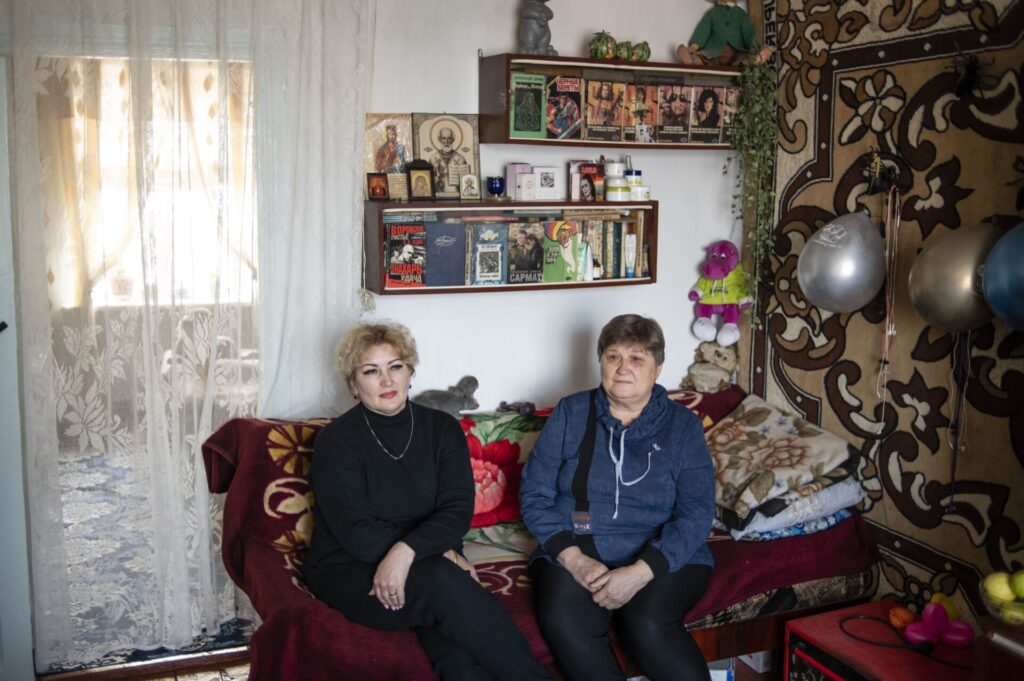
In January, Zorin was busy organizing to celebrate the Epiphany, the Orthodox holiday marking the baptism of Jesus in the Jordan River. (According to the Julian calendar used by the Russian Orthodox Church, Epiphany falls on Jan. 19, some 13 days later than the rest of the world’s Gregorian calendar.) On the eve of Epiphany, Zorin held a fireworks show. Fifteen people came, including some Kyrgyz children from the neighborhood. Zorin welcomed everyone and recited a short prayer.
Ahead of the holiday, Zorin posted in a WhatsApp chat the community uses called “Russkaya diaspora” (“Russian diaspora”). “Brothers and sisters, please come to take the holy water. It heals the wounds of body and soul.”
Hardly anyone heeds his message.
“On the Epiphany night God blesses all water in the universe,” says Aleksandra. “We don’t need a priest for that.” One of the Kyrgyz boys helped Zorin fetch the water for the celebration; bathing in ice-cold water is a tradition in the Russian Orthodox Church. But there are no streams or rivers in Suluktu, so the only option for the parishioners is to douse themselves with water in the churchyard. Zorin heats the water for Belova before pouring two buckets on her head. She shivers but tells herself it will help fight the cancer.
The young priest’s enthusiasm is slowly wearing off.
“My job is to pray. So, I pray. But inside it hurts. My therapist helps me organize my emotions, but I fail,” he says. His reliance on tranquilizers has led the local pharmacy to give him a discount for them.
He plans to bring in an eparch from Bishkek. “I want him to see this empty church,” he says. “And I will ask that they move me to Mailuu-Suu,” a mining town in southern Kyrgyzstan. The town was once one of the main uranium processing centers; the first Soviet atomic bomb to be detonated, in 1949, used uranium from Mailuu-Suu. Today it is considered one of the most polluted places on Earth, surrounded by radioactive waste. This does not dissuade Zorin. “Never mind the radiation! There are people there!” he says gleefully, describing how it is home to 3,000 Russians, 2,000 Ukrainians and many Tatars.
“Here I feel like a one-man show, but I need an audience,” he says. He hopes Mailuu-Suu is his next steppingstone. He then wants to become a metropolitan — a high-ranking bishop — perhaps even reaching Moscow one day.
This article was published in the Fall 2024 issue of New Lines‘ print edition.
The post A Russian Priest in Kyrgyzstan Has a Parish With No Followers appeared first on New Lines Magazine.
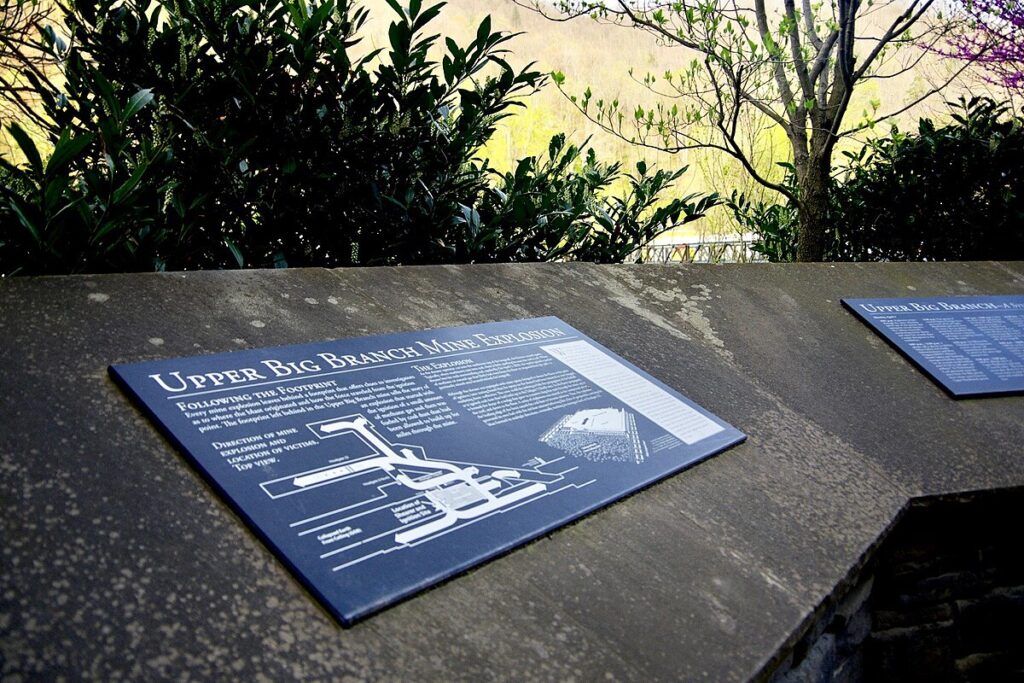
On April 5, 2010, the Upper Big Branch Coal Mine in Raleigh County, West Virginia exploded, killing 29 of the 31 workers laboring in the mine. The product of the outright hostility to safety by mine owner Don Blankenship, this terrible moment served as horrifying reminder both of the dangers of working in underground coal mines and of the vile perfidy of anti-worker employers.
Upper Big Branch was one of many mines owned by Massey Energy, the big conglomerate then run by Don Blankenship. This starkly anti-union company ran 47 mines in Appalachia, 37 of them underground. Most of these were in West Virginia, Kentucky, Tennessee, and Virginia. Blankenship took over as CEO in 1992 and built it up through aggressive buying of mines and keeping costs low through union busting and avoiding safety requirements.
At 3:27 PM on April 5, 2010, all the methane built up in the Upper Big Branch exploded. Coal mining has inherent dangers. But by 2010 we were well beyond the point where miners should be dying of this. Sure, a century earlier, this happened all the time. In fact, many of the worst workplace disasters in American history were coal mine explosions from this problem. But technological and safety advances meant that this could be pretty effectively measured and workers’ lives could be saved. Well, if they had a boss that cared whether they lived or died. The 31 workers in the Upper Big Branch did not have that boss. They had Don Blankenship. Only the two miners nearest the exit managed to get out from the gas, noise, and wind from the explosion. Of course, the carbon monoxide levels were so high that the rescue workers had to wait to start their operations for their own safety, making the likelihood of rescuing anyone even less likely, and of course they did not find anyone alive.
The Upper Big Branch explosion was the worst coal mine disaster in the United States since the Hyden, Kentucky disaster of 1970. Naturally, Massey did not inform the workers’ families. They found out on the news or the internet. Also, Blankenship and the rest of Massey denied any responsibility, making completely dubious claims that this was natural gas exploding. Give me a break.
To be clear, Blankenship was directly responsible for these deaths. Most of the time, there is some distance between the owner and the deaths, but not here. Blankenship was an extremely hands on owner. He personally ordered mine practices that were unsafe and oversaw duping Mine Safety and Health Administration inspectors. In fact, the levels of carbon monoxide were so out of control in the mine that MSHA inspectors had to wait almost three months to go inside. The MSHA report on the disaster was absolutely searing. It read, in part, “A company that was a towering presence in the Appalachian coal fields operated its mines in a profoundly reckless manner, and 29 coal miners paid with their lives for the corporate risk taking.” It found a systemic policy of violating safety laws by Blankenship and other executives. Workers told of being threatened with termination if they reported the safety violations.
But the MSHA and Department of Labor were hardly without blame too. They had inspected Upper Big Branch several times. And sure, Blankenship was ignoring the law. But MSHA fines simply were not big enough. In the previous five years, MSHA had found 1,300 violations!!!!! But for all these violations, in 2009, Massey was fined $382,000. But that’s a drop in the bucket for a company like this. And I get it, there are larger structural issues going on here. It’s really an issue of regulatory capture. The MSHA is no different than the EPA or DOL or a lot of agencies–for decades going back to the 80s, all of these agencies were captured by mining executives and hacks. So they kept the fines low, with the support of West Virginia politicians and of course the Republican Party. But…it’s worth noting that this happened under Obama’s watch. The point here is not to blame Obama. The point here is to note that Democratic presidents put far too little emphasis on taking back the regulatory agencies from corporate control. Biden was better around these issues and outraged corporate America for just slight levels of regulation, but that outrage also demonstrates how empowered corporate America really felt after decades of total control. And no, 29 dead workers did not matter.
Because Blankenship was so directly responsible, he actually faced some penalties. Of course, Massey itself was fined a lot. It paid $10.8 million in direct fines. Shortly after, it was purchased by Alpha Natural Resources and Alpha paid $209 million in corporate criminal liabilities. Blankenship fought the personal charges against him but in 2015, was convicted of willfully violating safety standards and sentenced to a year in prison. He claimed he was a political prisoner of a government that hated coal. I’d say that a year in prison for 29 murders was a pretty light sentence.
While in prison, Blankenship decided to write a political manifesto. From the news about it:
“You can be sure I am fully innocent,” he writes. “In fact, more than 100 percent innocent. I spent my life improving coal miner safety and exercising my right to free speech… The real conspiracies were the government’s cover-up of the UBB truth and my prosecution.”
Blankenship also commissioned a documentary in 2014, Upper Big Branch — Never Again, in which he and various consultants attribute the explosion to a freak surge of natural gas.
However, multiple investigations into the disaster found severely inadequate ventilation, plus a buildup of explosive coal dust, combined with a spark from equipment resulted in a series of mile-long blasts that trapped or incinerated dozens of workers. Blankenship had told Massey executives to put safety improvements on hold, writing to one executive in 2008, “We’ll worry about ventilation or other issues at an appropriate time. Now is not the time.”
It never is the time for scumbags like Blankenship.
This is the 559th post in this series. Previous posts are archived here.
The post This Day in Labor History: April 5, 2010 appeared first on Lawyers, Guns & Money.

I’m not saying we’re prepping for war with Iran, but if we’re not it’s hard to tell the difference. B-2s!
In the latest show of force against Iran and Yemen’s Houthi rebels, the United States has deployed at least six nuclear-capable B-2 bombers to a base in the Indian Ocean within striking distance of both countries, an ABC News analysis of satellite images shows.
The buildup of aircraft on the island of Diego Garcia – comprising at least one third of the Air Force’s stealth bombing fleet – accomplishes three tasks with one strategic move, increasing the United States’ military presence in the region, enabling continued strikes of targets in Yemen and sending a message to Iran, experts told ABC News.
The United States is increasing the number of aircraft carriers deployed in the Middle East to two, keeping one that is already there and sending another from the Indo-Pacific, the Pentagon says.
The Harry S. Truman will be joined by the Carl Vinson “to continue promoting regional stability, deter aggression, and protect the free flow of commerce in the region,” Pentagon spokesman Sean Parnell says in a statement.
F-35s and Warthogs and Patriot batteries, oh my!
The U.S. military has deployed more of its most advanced fighter jets to the Middle East as it continues to strikeYemen’s Houthi rebels, an Iran-backed terrorist group attacking commercial ships in the Red Sea, according to multiple congressional aides…
More than two weeks into the Trump administration’s intensified airstrike campaign in Yemen, Hegseth has rushed further military assets to U.S. Central Command. He’s extended the deployment of the Harry S. Truman Carrier Strike Group in the Red Sea and announced the carrier Carl Vinson and its strike group would soon join it. The Pentagon has also sent multiple A-10 Warthogs to the region…
Taken together, these factors have left many Israelis wondering why the Netanyahu government has not taken advantage of this relatively appealing strategic environment. A recent poll revealed 68 percent of Israelis favored striking Iran after recent successes against Hizballah. Without backing from the United States, however, only 37 percent of Israelis support a strike. Israelis understand that their informal alliance with the United States is critical to their security in a neighborhood as dangerous as the Middle East.
Trump has been characteristically all over the place:
Trump seems to be against a military strike, at least for now. In his inauguration speech, he said that his legacy will be measured by the “wars that we end — and perhaps most importantly, the wars we never get into.” During Netanyahu’s Feb. 4 visit to the White House, Trump downplayed the urgency to strike Iran immediately, stating “There’s two ways of stopping them: with bombs or with a written piece of paper. I’d much rather do a deal that’s not going to hurt them.” Trump’s first term demonstrated he is willing to use force against Iran in a way his successor would not. Nonetheless, he remains optimistic about a negotiated outcome.
Iran has reacted with outrage after Donald Trump said the country will be bombed if it does not accept US demands to constrain its nuclear programme.
The US president said on Sunday that if Iran “[doesn’t] make a deal, there will be bombing. It will be bombing the likes of which they have never seen before.”.
Trump’s latest threat – more explicit and violent than any made before – came after he sent a letter to Iran, as yet undisclosed, offering to hold talks on its nuclear programme. Iran had sent a reply to the US stating it was willing to hold indirect talks, officials confirmed.
I actually would be just a little bit surprised to see this happen. Trump 45 escalated US participation (and lethality towards civilians) in wars that the US was already engaged in, but he did seem trigger shy about starting major new conflicts. Blowing up Soleimani is one thing; hitting Iran with B-2 strikes is entirely another. But I certainly wouldn’t be shocked to see us go over the top kinetic against Iran in the next couple of weeks. Even if the intention is just coercive diplomacy, it’s possible that Trump will find himself backed into a corner if the Iranians don’t comply. When you’ve decided to blow up the world economy, why not blow up some Iranians as well?
The post “Not Great, Bob!” appeared first on Lawyers, Guns & Money.

“Nobody likes self-checkout,” CNN reminded us in 2022, something that has been true for decades. First introduced in Florida, the beachhead of so many other invasive species, the technology was not liked by large majorities of consumers right away. “From the get go,” CNN quoted an expert as saying, “customers detested them.” Given this response, many stores quit using them at least for a while. But like the giant Burmese python, Gambian pouched rat, New Guinea flatworm, and Elon Musk, self-checkout has proven harder than expected to get rid of.
In February, a Washington state lawmaker introduced House Bill 1739, which would put at least some restrictions on self-checkout in grocery stores. The bill would apply only to retail groceries that are over 15,000 square feet in size, so almost as big as your managing partner’s house, and would impose the following requirements:
- At least one manual checkout station would also have to be provided;
- Self-checkout stations would be limited to 15 items per customer;
- No more than two stations could be monitored by any one employee; and
- The employee monitoring them could not be Elon Musk or anyone associated with Elon Musk.
The bill would also require self-service checkout to be included in the “analysis of potential work hazards for purposes of any accident prevention programs required by law.” Does self-service checkout pose potential work hazards for employees? Apparently the people forced to use it do:
“On a particularly hard day, a woman threw a steak at me because her item did not qualify for a bogo deal we were running,” said Bellevue grocery clerk James Reed. “I would have overridden the machine given the chance. She just didn’t give it to me.”
Of course, throwing a steak at someone is assault, not an “accident,” so maybe the bill wouldn’t require analyzing such risks. In any event, I think we can all agree that the worst crime described above is writing “bogo” as if it were a real adjective and not (presumably) an acronym for “Buy One Get One [Free].” Maybe she threw the steak at him because he said it was a “bogo deal”? No jury of me would convict her for that.
The bill is primarily intended to protect grocery workers, although not from flying meat specifically. It seems aimed at preventing their jobs from being transferred to consumers (who don’t want that job anyway, so it indirectly protects them too). Employees could file a complaint with the state’s Department of Labor and Industries, and an employer found to have violated the law could be required to pay up to $10,000 in civil penalties. Or, of course, aggrieved employees could bring an action in superior court to get their jobs back or to recover lost pay or benefits. Most importantly, of course, they could also recover attorneys’ fees if they prevail. That just always makes sense.
Critics of the proposal said it would deprive stores of the flexibility they need to address worker safety (teaching workers to duck, maybe) and another significant problem: theft.
As CNN noted, the deployment of self-checkout lanes was quickly followed by the deployment of techniques for exploiting self-checkout lanes, such as scanning counterfeit bar codes or the far simpler techniques of “not scanning an item” or “scanning everything and then walking out without paying.” Also, customers make mistakes. “Consumers are not very good at scanning reliably,” one expert was quoted as saying. “Why should they be? They’re not trained.” Because of mistakes and theft, he had estimated, a store where 50% of transactions involved self-checkout would experience losses 77% higher than average.
Another expert pointed out that although stores might save money by replacing some human cashiers, the machines still require enough “supervision” and regular maintenance, often involving better-paid IT workers, that they may not save money overall. In short, he opined, self-checkout “delivers none of what it promises.”
So, CNN concluded, if most customers hate it and the technology delivers none of what it promises, it only makes sense that “self-checkout is here to stay.” Wait, what? Yes, despite self-checkout’s “many shortcomings for customers and store owners, the trend is only growing,” CNN suggested, noting that some retailers are planning or even operating stores (e.g. Amazon Go) that have no cashiers at all. Why turn everything over to a mildly functional technology that people hate? “It’s an arms race,” said one former grocery executive. “If everyone else is doing it, you look like an idiot if you don’t have it.” I guess that’s a reason, it just isn’t a good one.
It’s basically the same thing I keep hearing about generative AI. Lots of people hate it and it doesn’t deliver what it promises, so it’s definitely here to stay. Everybody’s doing it! Not me, and not you either if I’m supervising the project. I guess I can’t stop you from using it, but if I find out I will absolutely throw a steak at you. And not a good one, either.